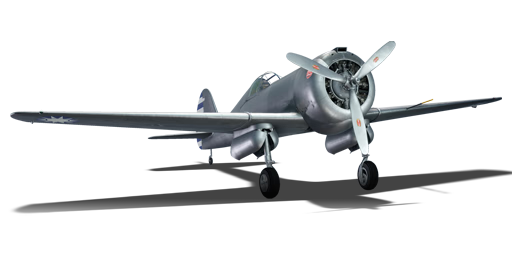




The CW-21 was a fighter interceptor based on the CW-19. Intended to be a high altitude fighter with good climb rate and good armament, it caught the interest of the Chinese government. China received 3 fully built CW-21s and 27 kits to be armed. Another three were sent to China and given to the Flying Tigers group. Other variants of the CW-21 were developed, like the CW-21B, which was used by the Dutch in an effort to modernize their air force. However, after the defeat to Germany, these aircraft were given to the Dutch East Indies. The CW-21 ended up being easy prey to the Japanese fighters, and their lightweight construction meant that cracks and structural failures were more common than in other planes.
Introduced in Update 1.91 "Night Vision", the CW-21 is a unique and capable fighter that excels in high altitude capabilities. It has an amazing climb rate good top speed, and so will it leave most of the other planes behind when it takes off and starts climbing. Unlike many aircraft, it's very competitive even in uptiers when facing aircraft like the A6M2 or the P-51, and in downtiers, it outmatches almost every opponent as long as it uses its good climb rate to get an advantageous position. The CW-21s armament is average for its rank, with 2 x .50 calibre M2s and 2 x .30 calibre M1919s. Even though this armament is not the best and lacks cannons, is enough to destroy any plane that it will fight with a few well-placed shots, while also having a good ammo pool and good range compared to most cannons at its BR. Thanks to its lightweight construction, the CW-21 is also very nimble, outmanoeuvring most aircraft in battle, except for biplanes and Japanese planes which are notorious for their excellent agility.
flaps
flaps
flaps
brake
| Belt | Belt filling | Armor penetration (mm) at a distance: | |||||
|---|---|---|---|---|---|---|---|
| 10 m | 100 m | 500 m | 1000 m | 1500 m | 2000 m | ||
| T/Ball/I/AP | 30 | 27 | 20 | 13 | 9 | 6 | |
| AP/AP/AP/T/I | 30 | 27 | 20 | 13 | 9 | 6 | |
| T/AP/AP/AP | 30 | 27 | 20 | 13 | 9 | 6 | |
| T/T/T/AP | 30 | 27 | 20 | 13 | 9 | 6 | |
| AP/I/AP | 30 | 27 | 20 | 13 | 9 | 6 | |
| Belt | Belt filling | Armor penetration (mm) at a distance: | |||||
|---|---|---|---|---|---|---|---|
| 10 m | 100 m | 500 m | 1000 m | 1500 m | 2000 m | ||
| T/Ball/Ball/Ball/AP/I | 13 | 12 | 7 | 3 | 2 | 0 | |
| T/AP/I | 13 | 12 | 7 | 3 | 2 | 0 | |
| AP/T/T/T/T | 13 | 12 | 7 | 3 | 2 | 0 | |
| AP/AP/AP/I/I | 13 | 12 | 7 | 3 | 2 | 0 | |












Flight performance | |
|---|---|
Survivability |
|---|
Weaponry | |
|---|---|